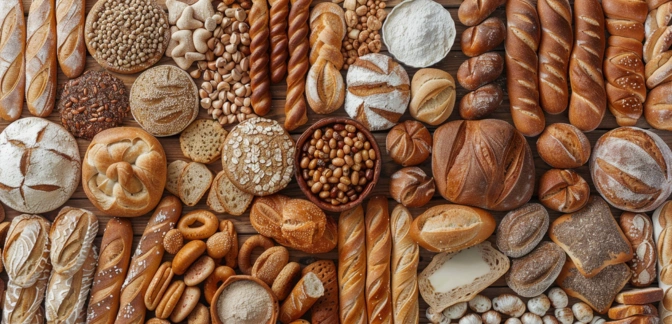White Bread — Nutrients, Health Benefits, And Shopping Tips

Written by Listonic Team
Last update on September 4, 2024
White bread nutrients
Nutrition facts
Amount per 100 g
Calories
🔥 265 kcal
| Nutrition per: 100 g | Value | % Daily Value* |
|---|---|---|
| Carbs | 49 g | 17.82% |
| Fiber | 3 g | 10.71% |
| Sugars | 5 g | 10% |
| Glycemic Index | 75 | - |
| Protein | 9 g | 18% |
| Sodium | 491 mg | 21.35% |
| Total Fat | 3 g | 3.85% |
*The % of Daily Value (DV) tells you how much a nutrient in a serving of food contributes to a daily diet. 2,000 calories a day is used for general nutrition advice.
3 g
🥕 Low Fat Content
5 g
🍏 Low Sugar Content
White bread facts & tips
Health benefits
- Provides quick energy due to its simple carbohydrate content, making it a fast source of fuel for the body and brain.
- Contains essential vitamins and minerals if enriched, such as iron and B vitamins (like folic acid), which support overall health and well-being.
- Soft and easily digestible, making it suitable for individuals with sensitive digestive systems or those recovering from illness.
Health risks
- High carbohydrate content particularly in white bread made from refined flour, which can cause rapid spikes in blood sugar levels, particularly concerning for diabetics.
- Low nutrient density as white bread offers limited vitamins and minerals compared to whole grain options.
- High sodium content in some commercial white bread products, which can contribute to hypertension and increased cardiovascular risks.
- Potential for overconsumption due to its palatable nature, leading to excessive calorie intake if not mindful of portion sizes and toppings.
- Gluten content making it unsuitable for individuals with celiac disease or gluten sensitivity, potentially causing digestive discomfort and other health issues.
How to choose white bread
White bread should be soft and springy, with a uniform crumb and a slightly sweet taste. The crust should be light and not too thick, providing a gentle crunch when toasted.
Avoid white bread that is overly dense or dry, as it may be stale. Bread with mold or an unusual odor should also be avoided, as it is not fit for consumption.

How to store white bread
White bread should be stored at room temperature in an airtight container or bread box. Proper storage keeps it soft and fresh for up to a week.
Air exposure can cause white bread to become stale. Avoid refrigerating the bread, as this can dry it out. Wrapping it tightly ensures the best texture and flavor. Consume within a few days of purchase for optimal freshness.
✅ Extra Tip
How long does it last?
White bread can last for 3-5 days at room temperature when stored in an airtight container. For longer storage, white bread can be frozen for up to 3 months.
What to do with leftovers?
Leftover white bread can be used in a variety of savory and sweet dishes. Use it to make sandwiches, paninis, or grilled cheese, or toast it and serve with butter, jam, or honey for a quick breakfast. White bread is also great when turned into croutons by cubing, tossing with olive oil and seasonings, and baking until crispy.
Use leftover white bread to make a bread pudding by tearing it into pieces and mixing with eggs, milk, and spices, then baking until set. If you have a lot of white bread, consider using it to make French toast by dipping it in an egg mixture and frying until golden. White bread can also be used as a base for bruschetta or crostini, topped with tomatoes, cheese, and fresh herbs, or blended into breadcrumbs for coating meats or vegetables. For a quick snack, enjoy white bread with cheese, cold cuts, or a spread like peanut butter or Nutella.
👨⚕️️ Medical disclaimer
Discover products from other categories
Listonic Team
Fact-checked
Our editorial team checked this article to make sure it was accurate at the time of publishing it.
Get the top-rated shopping list app

white bread
1 piece
Outline







